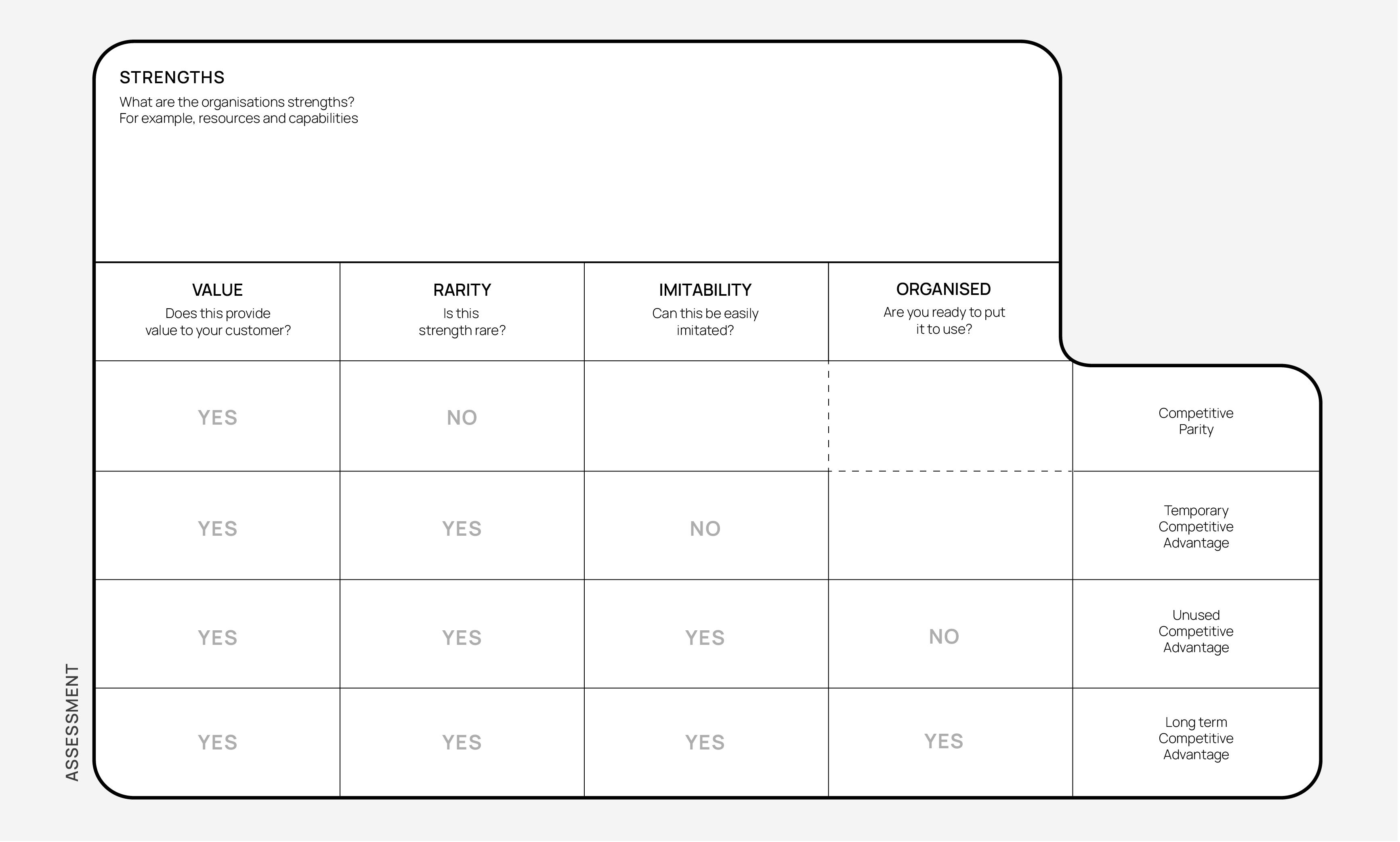VRIO
VRIO is a strategic tool that organisations use to figure out what they are uniquely good at and how their strengths can give them an edge over competition.
VRIO evaluates strengths against the following four questions:
- Is what we do valuable?
- Is what we do rare?
- Is it hard for others to copy? (Imitable)
- Are we organised enough to make a real go of it? (Organisation)
Key concepts important in using VRIO:
Strengths: Things the organisation is particularly good at. These are usually framed as resources or capabilities.
Resources: Things the organisation has. These might be assets owned or controlled by an organisation such as equipment, people or brand reputation.
Capabilities: Things the organisation can do. These might be skills an organisation uses to create value, such as having a unique operating model or exceptional customer service.
Each strength is sorted into one of the following categories:
Competitive disadvantage: When a strength doesn’t help the organisation compete against rivals.
Competitive parity: When a strength is common amongst the competition, so it doesn’t offer special advantage over rivals.
Temporary competitive advantage: When a strength offers an advantage over the competition for now, but is likely that rivals will copy.
Unused competitive advantage: When a strength is valuable, rare, and hard to copy, but the organisation is not fully using it to maximum benefit.
Long term competitive advantage: When a strength is valuable, rare, hard to copy and fully exploited by the organisation.
The results
- A clear idea of the organisations unique value proposition
- A view on where to invest resources to leverage strengths

When to use it
Strategy Formulation: When formulating strategy
Strengths Assessment: When figuring out an organisations strengths
Unique Value Proposition: When identifying unique strengths that set the organisation apart
Competitive analysis: When comparing a product or service offering with competitors
Strengths
Highlights unique value
Aligns resources with strategy
Weaknesses
Can be short-term focussed
Overlooks market demand
Can oversimplify complex situations
How to use it?
What do I need to start?
- A clear understanding of what resources and capabilities the organisation has
- Insights on competitors strengths and value propositions
How to use it?
Who to involve?
- People who understand the organisations direction and goals
- People who have insights into the competition
- People who have an understanding of what resources and capabilities the organisation has
- People who can advise on the organisations ability to implement initiatives
Step by step
1
Make a list of strengths
Brainstorm the organisation’s strengths. Categorise strengths into ‘resources’ and ‘capabilities.’
Example resources:
- Financial: Money, shares, bonds
- Physical: Buildings, machinery, technology
- Human: Number of skilled employees
- Intangible: Brand reputation, intellectual property, company culture
- Organisational: Processes, systems, relationships
Example capabilities:
- Operational Efficiency: Logistics and inventory management
- Innovation: Continuous development of new technologies and services
- Customer Service: Customer support and user experience
- Marketing: Data analytics for targeted marketing
2
Evaluate each strength
Value
- Does this strength help us meet customer needs better than our competitors?
- Does the strength enable the organisation to exploit opportunities or neutralise threats?
- Can this strength increase revenue?
If yes, proceed with Rarity assessment. If no, then the strength is a competitive disadvantage.
Rarity
- Is this strength rare?
- Is this strength unique to our organisation?
If yes proceed with Imitability assessment. If no, then the strength has competitive parity.
Imitability
- Is it difficult for competitors to imitate the strength?
- Is this strength protected by patents or trademarks?
- Does this strength rely on complex processes or unique skills?
If yes proceed with Organisation assessment. If no, then the strength has temporary competitive advantage.
Organisation
- Is the organisation structured to fully utilise the strength?
- Does the organisation possess the right systems and processes to leverage this strength?
- Are employees trained to maximise this strength?
If yes, then this strength has long term competitive advantage. If no, then the strength is an unused competitive advantage.
3
Develop an action plan
Prioritise and leverage strengths: Focus on using high-scoring strengths to create a competitive advantage.
Develop strategic initiatives: Create and implement plans that leverage strengths.